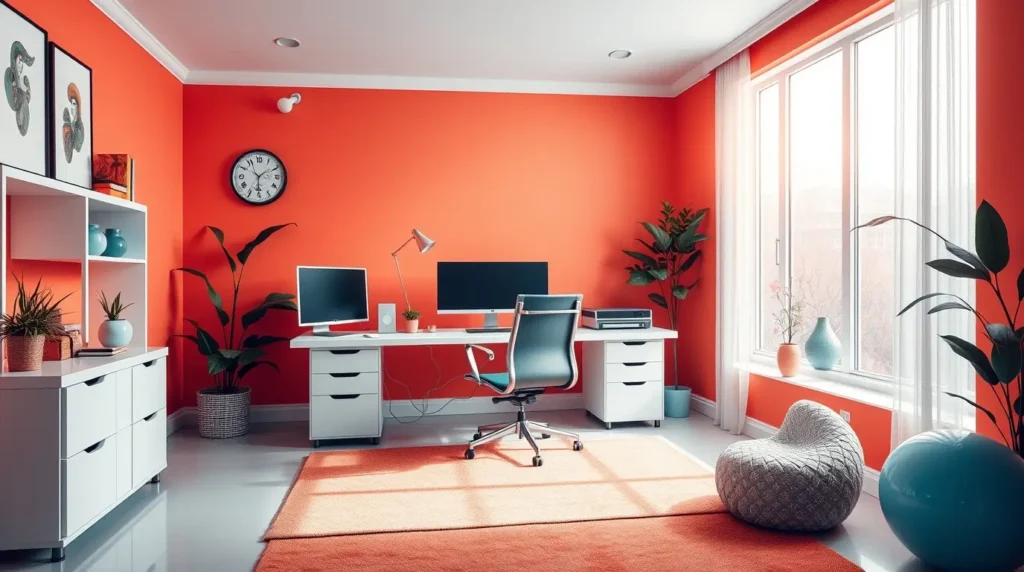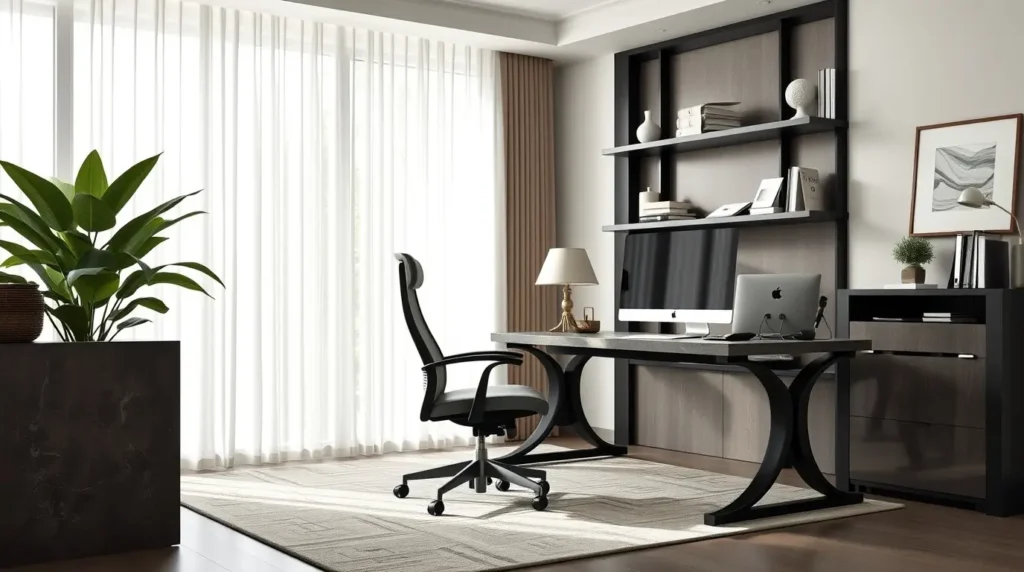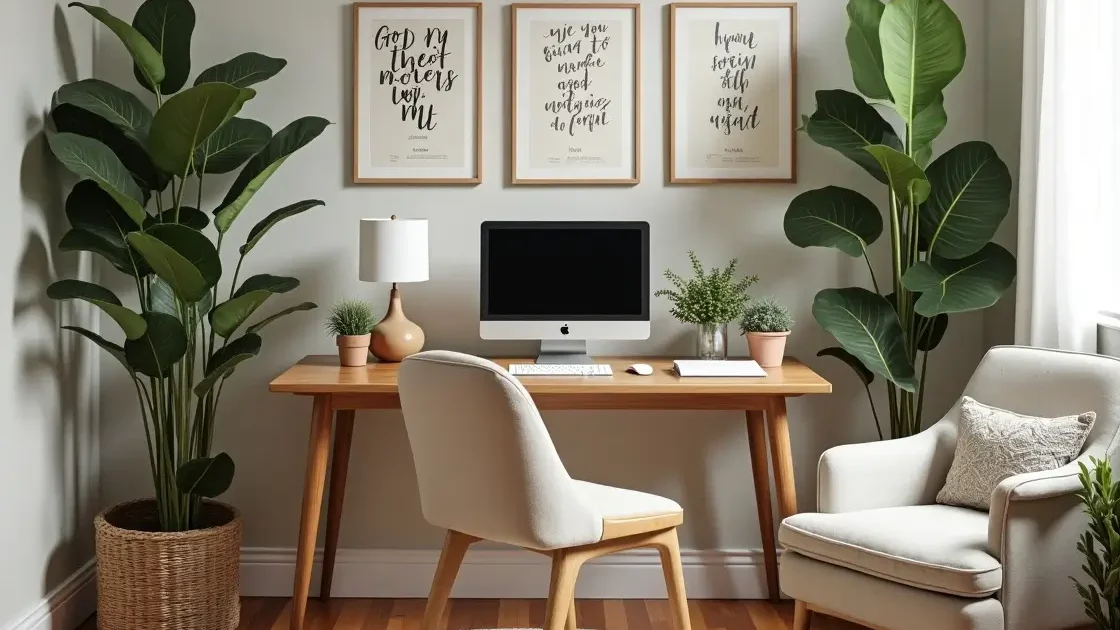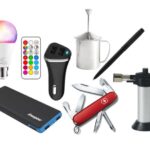Have you ever wondered how transforming your home office can completely change your work-from-home experience? Imagine a space where every detail—from the perfect desk setup to carefully chosen lighting—works in harmony to boost your focus and energy. When your environment is tailored to your needs, every task feels more achievable and your productivity soars.
In today’s dynamic work landscape, setting up a home office for maximum productivity isn’t just a luxury—it’s a necessity. By combining smart home office tips with practical design strategies, you can create an environment that not only supports your work but also enhances your overall well-being. Whether you’re a remote work veteran or just beginning your journey, integrating elements like ergonomic furniture and distraction-free zones can make a significant difference in your daily routine.
Are you ready to discover how small changes can lead to big improvements? Picture having a workspace where every element, from advanced productivity tools to organized storage solutions, is designed to help you thrive. If you’re curious about the latest insights into ergonomic design, consider checking out this Mayo Clinic resource on office ergonomics for expert advice.
Let’s dive in and explore how you can create and maintain a productive home office that truly supports your goals—one step at a time.
Designing an Ergonomic & Efficient Workspace

Have you ever wondered how a well-designed workspace can turbocharge your daily productivity? In a home office setup, every detail matters—from selecting the right furniture to ensuring the lighting complements your work style. Let’s break down how you can transform your space into an environment that not only boosts your efficiency but also cares for your well-being.
Key Components of an Ergonomic Workspace
- Furniture that Supports You
Choosing the right desk and chair is the first step toward an ergonomic workspace:
- Invest in Quality Seating: Look for chairs that offer lumbar support and adjustable settings.
- Desk Considerations: Ensure your desk has enough surface area for your devices, documents, and a few personal touches that inspire you.
- Suggested External Link: For more on ergonomic furniture, consider linking to a reputable source like Mayo Clinic’s office ergonomics guidelines using the anchor text “office ergonomics guidelines”.
- Optimizing Ergonomics & Posture
Keeping your posture in check can significantly improve your focus and reduce physical strain:
- Monitor Placement: Position your monitor at eye level to prevent neck and eye strain.
- Keyboard and Mouse Setup: Arrange them to maintain a natural wrist position, ensuring your arms are relaxed.
- Regular Breaks: Incorporate short breaks into your routine to stretch and reset your posture.
- Suggested External Link: Embed a link to the CDC ergonomics guidelines with the anchor text “ergonomic best practices” for added credibility.
- Integrating Essential Tech & Connectivity Tools
Modern technology can streamline your workflow and keep distractions at bay:
- High-Speed Internet: Ensure reliable connectivity to support video conferences and cloud-based applications.
- Productivity Tools: Use task management and digital calendar apps to keep your schedule organized.
- Cable Management: Implement simple solutions like cable trays or clips to maintain a tidy space.
- Bullet List of Must-Have Tools:
- Noise-cancelling headphones
- Ergonomic keyboard and mouse
- Dual monitors or an ultra-wide screen
- Smart lighting solutions
- Setting Up Optimal Lighting for Focus
Proper lighting can make your workspace inviting and reduce eye fatigue:
- Natural Light: Place your desk near a window if possible to enjoy natural sunlight.
- Ambient & Task Lighting: Use adjustable lamps to create a balanced light environment, reducing glare on screens.
- Energy Efficiency: Consider LED bulbs that save energy and offer customizable brightness levels.
- Suggested External Link: Consider referencing an industry study on lighting and productivity by linking to a trusted resource such as Harvard Business Review’s research on workplace productivity with the anchor text “workplace productivity research”.
Bringing It All Together
By focusing on these key components, you create an environment that supports both your physical health and work efficiency. Ask yourself: Could a few adjustments to your current setup make a significant difference in your daily performance? The answer is likely yes. Implementing these changes not only boosts your productivity but also makes your home office a pleasant and inspiring place to work.
Remember, each element—from furniture to tech tools—plays a vital role in maximizing your home office productivity. As you experiment with these ideas, be sure to personalize your space and make it uniquely yours. The journey to an efficient workspace is continuous, and small tweaks today can lead to big wins tomorrow.
Creating a Distraction-Free Environment
Imagine starting your day in a home office where distractions are minimized and every element works in your favor. A distraction-free workspace isn’t just about removing noise—it’s about creating a holistic environment that supports your focus and nurtures productivity.

1. Minimize Physical Distractions
A cluttered environment can sap your energy and distract your mind. Here are some actionable tips to transform your space:
- Clear the Clutter:
- Remove unnecessary items from your desk.
- Keep only essential tools and personal items that inspire you.
- Designate a Dedicated Workspace:
- Use a separate area exclusively for work to reinforce your focus.
- Arrange furniture to create clear boundaries between work and leisure.
- Implement Noise Reduction:
- Consider using noise-cancelling headphones or a white noise machine.
- If possible, invest in soundproofing elements like thick curtains or acoustic panels.
2. Set Boundaries to Enhance Concentration
Establishing clear work-life boundaries is key to reducing interruptions and maintaining a steady workflow:
- Create a Routine:
- Set consistent start and end times to your workday.
- Schedule regular breaks to reset your focus and prevent burnout.
- Communicate Your Schedule:
- Inform household members of your dedicated work hours to minimize interruptions.
- Use visual signals like a closed door or a status sign indicating “Do Not Disturb.”
- Digital Detox Practices:
- Silence non-essential notifications on your devices during work hours.
- Allocate specific times for checking emails and social media.
3. Tackle Digital Distractions Head-On
Digital clutter can be just as disruptive as physical clutter. Consider these steps to regain control over your digital workspace:
- Optimize Your Digital Environment:
- Organize your desktop with clearly labeled folders and minimal icons.
- Use browser extensions or apps that block distracting websites during peak work hours.
- Utilize Productivity Tools:
- Integrate tools like task managers, calendar apps, and time trackers into your routine.
- Regularly review and update your digital workflow to keep it efficient.
- Manage Email & Messaging:
- Set designated times for email and messaging to prevent constant interruptions.
- Use features like “Do Not Disturb” on communication platforms to stay focused.
4. Build a Mindful Work Environment
Integrating mindfulness into your workday can further mitigate distractions and enhance overall productivity:
- Short Mindfulness Breaks:
- Incorporate brief meditation sessions or breathing exercises throughout your day.
- Use guided meditation apps to help you stay centered.
- Ergonomic Comfort:
- Adjust your seating and screen setup to reduce physical strain, which can indirectly lower distraction levels.
- Personal Touches:
- Add elements like plants or inspirational artwork that foster a calming atmosphere.
Leveraging Advanced Productivity Tools & Techniques
In today’s fast-paced digital world, integrating advanced productivity tools can transform your home office into a powerhouse of efficiency. Whether you’re juggling multiple projects or managing daily tasks, the right digital tools and techniques make all the difference. Let’s explore how to harness these technologies and strategies to enhance your workflow and boost your productivity.
Utilizing Digital Tools & Workflow Apps
Digital tools are more than just software—they’re the backbone of a modern, efficient workspace. By incorporating workflow apps into your routine, you can automate repetitive tasks and keep your focus where it belongs. Consider these actionable tips:
- Streamline Your Workflow:
- Centralize Communication: Use collaboration tools like Slack or Microsoft Teams to keep team conversations organized.
- Cloud Storage Solutions: Platforms like Google Drive or Dropbox ensure you can access your files from anywhere.
- Automation: Explore tools like Zapier to automate repetitive tasks, saving you valuable time.
- Experiment and Adapt:
- Try New Apps: Regularly test out emerging productivity apps to find what best fits your working style.
- Integration Matters: Ensure your chosen tools integrate seamlessly with your existing software ecosystem.
- Quick Checklist for Digital Tools:
- Identify your most time-consuming tasks.
- Research workflow apps that address these needs.
- Test integrations and adjust based on feedback.
Mastering Time Management Strategies
Effective time management is crucial in maintaining a productive home office. By mastering how you allocate your time, you can ensure every minute is spent wisely. Here’s how to get started:
- Adopt Proven Techniques:
- Time Blocking: Allocate specific periods for focused work, meetings, and breaks to maintain a balanced schedule.
- The Pomodoro Technique: Work in 25-minute increments with short breaks to enhance concentration and stave off burnout.
- Set Priorities: Start your day by listing the top three tasks that must be completed, then work through them methodically.
- Evaluate Your Schedule:
- Daily Reviews: Reflect on your day to understand what worked and what didn’t, allowing you to adjust your approach.
- Flexible Planning: While structure is important, allow flexibility for unexpected tasks or creative breakthroughs.
- Numbered List of Time Management Tips:
- Start with a clear plan for the day.
- Use a digital calendar to schedule tasks.
- Monitor your productivity using time-tracking apps.
Task and project management systems help keep you organized and ensure nothing falls through the cracks. By setting up a robust system, you can manage deadlines, assign tasks, and track progress seamlessly. Consider the following strategies:
- Choose the Right Platform:
- Task Management: Tools like Todoist or Microsoft To Do are excellent for daily task tracking.
- Project Management: Platforms such as Trello, Asana, or Monday.com offer visual boards and timelines to keep projects on track.
- Systematize Your Work:
- Prioritize Tasks: Use labels, due dates, and priority levels to manage your workload effectively.
- Break Down Projects: Divide large projects into smaller, manageable tasks to maintain steady progress.
- Workflow Best Practices:
- Regular Updates: Keep your task lists updated and review your project timelines regularly.
- Collaborative Tools: If you work with a team, ensure everyone has access to the project management system and understands the workflow.
By leveraging digital tools, mastering time management, and implementing effective task and project management systems, you can elevate your home office productivity to new heights. Ask yourself: What one tool or strategy can you introduce today that will set you up for success tomorrow? Embrace these advanced techniques and watch as your productivity soars while your workday becomes smoother and more enjoyable.
Personalizing Your Space for Enhanced Wellbeing
Imagine your home office not only as a place to work, but as a sanctuary that nurtures both productivity and well-being. Personalizing your space can make a world of difference—small, thoughtful touches can transform an ordinary room into a vibrant, energizing environment. Let’s explore practical ways to add personality, comfort, and a touch of nature to your workspace.

Incorporating Biophilic Design & Natural Elements
Bringing nature indoors is more than just a trend—it’s a proven strategy to boost creativity and reduce stress. Consider these ideas:
- Add Greenery:
- Place potted plants or a vertical garden near your work area.
- Use low-maintenance succulents or ferns that thrive indoors.
- Natural Materials & Textures:
- Integrate wood, stone, or bamboo elements in your furniture or decor.
- Choose fabrics and finishes that mimic natural patterns.
- Maximize Natural Light:
- Position your desk near a window to enjoy daylight, which can improve mood and energy levels.
- Use sheer curtains to diffuse harsh sunlight while maintaining brightness.
Suggested External Link:
For further insights, consider linking to a study on the “impact of natural elements in the workplace” from a reputable source like Harvard Business Review or Human Spaces.
Adding Ergonomic Decor & Personal Touches
Your home office should reflect your personal style while supporting your physical well-being. Here’s how to balance aesthetics with ergonomics:
- Ergonomic Accessories:
- Choose a chair with proper lumbar support and an adjustable desk to suit your body.
- Incorporate a footrest or ergonomic keyboard to minimize strain.
- Personal Touches:
- Decorate with artwork, photos, or inspirational quotes that motivate you.
- Use color psychology—soft blues or greens can create a calming atmosphere.
- Layered Lighting:
- Combine ambient, task, and accent lighting to create a balanced environment that’s both functional and inviting.
Creating Relaxation & Break Zones
Taking regular breaks is essential for sustained productivity. Designate areas in your home office that encourage relaxation and mental recharge:
- Dedicated Break Area:
- Set up a comfortable corner with a cozy chair or bean bag where you can read or meditate.
- Consider a small bookshelf or a side table with calming decor.
- Mindfulness Practices:
- Integrate elements that encourage mindfulness—perhaps a small indoor fountain, essential oil diffuser, or soft background music.
- Quick Stretch Zones:
- Keep a yoga mat nearby for short stretching sessions during your breaks.
- Actionable Steps:
- Identify a quiet corner in your workspace.
- Add a few comfortable and visually soothing items.
- Set a timer to remind yourself to take regular breaks.
By thoughtfully integrating natural elements, ergonomic decor, and dedicated relaxation areas, your home office can evolve into a holistic environment that fuels both your productivity and well-being. Ask yourself: How can these small changes make a big difference in your daily work life? Every personalized detail is a step toward a workspace that truly reflects your needs and aspirations.
Maintaining & Evolving Your Home Office Setup
Keeping your home office setup in top shape is an ongoing process. How often do you step back and assess your workspace? Regular evaluations and timely upgrades can ensure your environment continues to support your productivity, even as your work needs evolve.
Conducting Regular Workspace Evaluations
A well-maintained home office requires periodic check-ins to ensure it still meets your needs. Consider these steps for a thorough evaluation:
- Self-Assessment:
- Ask yourself: Is your workspace still comfortable and conducive to productivity?
- Identify any recurring issues—maybe your chair isn’t as supportive as it once was, or your layout feels cramped.
- Feedback Loop:
- If you share your space with others or collaborate frequently, ask for feedback.
- Use short surveys or even informal discussions to pinpoint improvement areas.
- Checklist for Workspace Evaluations:
- Review ergonomics: Is your furniture still aligned with your posture needs?
- Examine tech setups: Are your devices operating efficiently?
- Check organization: Is clutter creeping back in, or have you outgrown your storage solutions?
Investing in Upgrades & Technological Advancements
Technology and design trends are always evolving. Are you keeping up? Investing in upgrades can make a substantial difference in both comfort and efficiency.
- Modernize Your Equipment:
- Upgrade outdated technology—consider faster computers, high-resolution monitors, or smart lighting systems.
- Look for energy-efficient devices that not only perform well but also reduce your utility costs.
- Smart Investments:
- Prioritize tools that offer measurable improvements. For example, a new ergonomic chair might boost your comfort while reducing long-term health risks.
- Integrate automation tools to streamline repetitive tasks, freeing up more time for creative work.
- Steps to Implement Upgrades:
- Identify outdated or inefficient equipment.
- Research the latest models or software tools that suit your workflow.
- Create a budget and timeline for gradual updates.
Adapting to Evolving Work Needs
Your work demands change over time—so should your workspace. Flexibility is key to maintaining long-term productivity.
- Future-Proof Your Office:
- Consider modular furniture that can be reconfigured as your needs shift.
- Plan for scalability; for instance, if your work expands, ensure there’s room for additional monitors or creative spaces.
- Stay Informed:
- Regularly read industry reports and expert articles to keep abreast of emerging trends and best practices in home office design.
- Participate in online communities or forums where professionals share tips on adaptive workspaces.
- Adaptation Strategy:
- Schedule quarterly reviews to assess your current setup.
- Keep a running list of potential improvements as you discover new trends.
- Experiment with new configurations and measure their impact on your workflow.
Wrapping up your journey toward a more efficient and inspiring home office, let’s take a moment to reflect on what you’ve learned and envision the possibilities ahead. By implementing smart design choices and embracing both digital and physical strategies, you can create a space that not only boosts your home office productivity but also nurtures your well-being every day.
Consider these key takeaways:
- Ergonomic Excellence: Investing in quality furniture and optimizing your workspace layout ensures that every tool—from your desk to your chair—supports your health and productivity.
- Distraction-Free Environment: Whether it’s minimizing clutter or setting clear work-life boundaries, reducing distractions is crucial for maintaining focus.
- Advanced Tools & Techniques: Harnessing digital tools, mastering time management, and implementing effective project systems can streamline your workflow and keep you ahead of the curve.
- Personalized Wellbeing: Infusing your space with natural elements, ergonomic decor, and dedicated break zones transforms your office into a sanctuary that fuels creativity and resilience.
- Continuous Improvement: Regular evaluations and timely upgrades help your home office evolve alongside your changing work needs.
Ask yourself: What small change could you make today that will lead to a big leap in your productivity tomorrow? With a few adjustments and the right resources, you can transform your home office into a dynamic hub that inspires innovation and success.
For additional insights on optimizing your workspace, consider exploring the Mayo Clinic’s office ergonomics guidelines for expert advice on setting up a comfortable, productive environment. You might also find valuable strategies and case studies on boosting workplace efficiency at Harvard Business Review.
Remember, your home office is a reflection of your professional aspirations. Embrace the journey of continuous improvement and watch as your dedicated space becomes a catalyst for success, creativity, and balance.






3 Comments